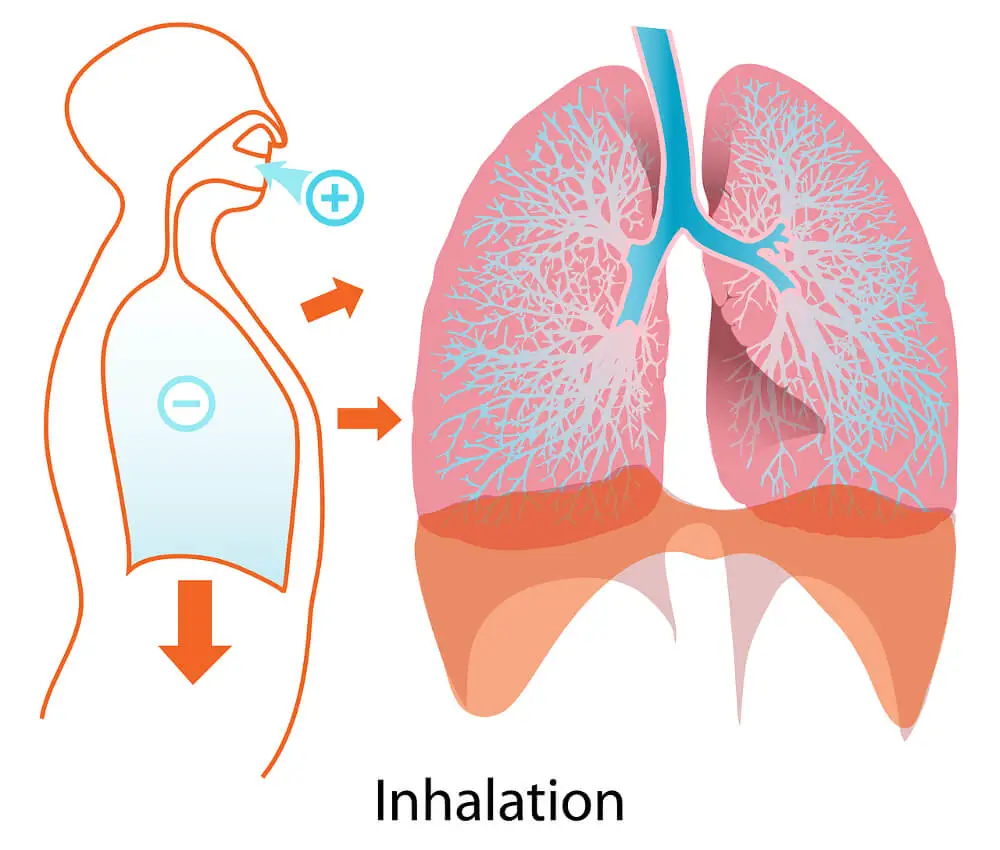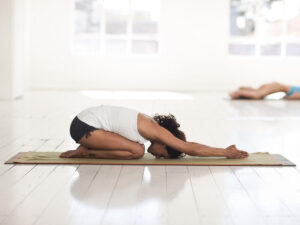While performing Pilates exercises, it is important to adjust your breath to the movement you make.
Proper breathing techniques are important and exercises done without it are incomplete.
There are two main muscles which control breathing, and those are the diaphragm and obliques. With time, you will learn how to control your breath and movement at the same time.
Most common Pilates breathing techniques are lateral breathing (also known as intercostal breathing) and diaphragmatic breathing.
These two techniques have certain similarities, but they are different. In both techniques, deep, controlled and slow breaths are essential.
To know more about breathing techniques in Pilates, read the following chapters:
Why is Breathing in Pilates so Important? [benefits]
Breathing in Pilates is very important for right muscle group activation.
You all know that Pilates exercises are focused on core muscles. Proper breathing techniques enable you to keep your abdominal muscles contracted while breathing at the same time.
This can even increase your safety while performing exercises and reduce the possibility of injuries.
When breathing laterally, you are expanding your rib cage (more about this is going to be mentioned in the following chapters) instead of “inflating your stomach”.
Pilates breathing techniques prevent shallow breathing which causes tension in your neck and shoulders. Shallow and fast breathing is characterized by breaths which do not fill your lungs and those uncontrolled breaths can cause loss of body movement control.
Contracting your pelvic muscles on the inhale enables activation of deep core muscles, which is one of the main goals of practicing Pilates.
During exhale, your transversus abdominis is going to contract and that is important for stabilizing your spine.
Slow but firm exhale enables better muscle contraction. Holding your breath is not advisable, for the same reasons as shallow and fast breathing.
For beginners, this may seem complicated and they tend to forget about their breathing.
In the beginning, you will have to concentrate on your breath, but after some time, it will come naturally, and you wont even notice it anymore.
In Pilates, every movement is coordinated with breath, and certain contractions happen on both inhale and exhale.
If you are not familiar with it, I am going to mention some breathing exercises later on.
Besides better muscle control and safety, Pilates breathing benefits include oxygen level increase, stress reduction, and blood circulation improvement.
Bonus: Here you can also check, Why is Pilates Good for You? [TOP 5 Benefits].
Different Types of Breathing Techniques in Pilates
I have already mentioned two main breathing techniques in Pilates, and those are Lateral breathing and diaphragmatic breathing.
Lateral breathing is the most important and most commonly used ones.
Both will help with muscle control, and enable you to use as much oxygen as possible. We all know that poor breathing leads to tiredness and poor exercise performance.
Here I am going to explain the difference between these two types of breathing, but I will focus more on the Pilates lateral breathing in the following chapter.
Lateral breathing is done in a way that you expand your rib cage on an inhale, but your lower belly remains static, and muscles are contracted. Thoracic and back muscles enable this movement.
The name lateral comes from the fact that instead of expanding down, you are expanding your ribs laterally.
This technique requires a bit more practice and concentration than diaphragmatic breathing.
Diaphragmatic breathing comes more naturally.
The goal of this breathing technique is to breathe in as much air as possible to get all the benefits of proper breathing. Unlike lateral breathing, this technique uses diaphragm to suck in the air and it causes belly expansion too.
This technique is not often done during exercises, especially not the core ones, but it is great for light stretching or relaxing purposes.
In fact, diaphragmatic breathing should be done on a daily basis. It is also one of the common Yoga breathing techniques.

What is Lateral Breathing in Pilates?
So, let’s get back to Pilates lateral breathing. Here I am going to explain it in detail.
When breathing laterally, you breath in deeply.
It can be described as breathing down the spine all the way to your pelvic. You should feel the breath through your upper body.
While doing it, your breath should cause back and side expansion, and your abdominal muscles should remain pulled in. When these muscles are pulled in in the right way, they stabilize and protect your spine, which is crucial for your safety when exercising.
These muscles are extremely important in holding you upright and improving posture.
If you do it properly and pull in your abdominal muscles, you should feel a light sense of spine lengthening on the inhale.
But, it is not just about inhales, exhales are important too. The right exhale has to be controlled, firm and strong.
While breathing, especially when you practice lateral breathing during exercises, you shouldn’t try to inhale more than you can or exhale so hard that you run out of air.
Deep breaths in and out are important, but be aware of your lungs and capacity.
Are There Any Pilates Breathing Exercises?
Pilates breathing exercises are a great way to practice breathing techniques before you try to match them with body movement.
Pilates breathing for beginners can seem hard, but here are a few exercises you can try to understand all this theory.
Here are steps to do so …
Lateral breathing
1. Take a few deep and slow breaths. Inhale trough your nose and exhale through your mouth. Breaths should be deep but not forced. Do dis in a seating position.
2. Now, you should put your hands on your ribs, and let your fingers touch on your chest bone. On an inhale, you should feel your rib cage expanding to the sides and the fingers should move away from each other. This means that your rib cage is expanding in the right way. Make sure your abs are not getting loose and expanding too.
4. Exhale steadily and firmly, but not too fast. Repeat the process until you figure it out.
5.Try to contract your abdominal muscles as you breathe to get the feeling how it will look like during an actual exercise.
Diaphragmatic breathing
1. Sit on a chair or even lay down if you want. Place one hand on your belly and other one on your chest.
2. Inhale slowly through the nose and feel you belly expand. Focus on “filling” your belly first. You will feel your belly pushing your hand.
3. Keep inhaling and when the belly is full, keep spreading your chest to get even more air in. You will feel this movement on your other hand. Keep your shoulders relaxed and your spine in a neutral position.
4. When the inhale is over, start exhaling. Do it through your nose too (opposite than in lateral breathing). Let the air from your upper part first and continue down to the belly. Do it naturally, do not force the air out.
5. Repeat the process a few times. When you get comfortable doing this, you can try to activate your abdominal muscles in and up during exhale, to help you release the air out.
If you feel any dizziness or discomfort, stop and go back to your normal breathing.
What is the Difference Between Pilates and Yoga Breathing?
Both Pilates and Yoga have breathing techniques which are used while exercising.
In Yoga, there is more of those …
Breathing in Pilates and breathing in Yoga are different, but there is no wrong or right way. The goal of breathing exercises is different and serves a different purpose.
In Pilates, breath is used to activate certain muscle groups and keep them contracted, especially on a exhale, where contractions are even harder.
In Yoga, breaths can be use in a similar way as in Pilates, to accompany our movements, but some breaths are there which help us on a spiritual level, not physical one.
Breathing, especially deep breathing improves body awareness, and certain techniques are used in meditations. Breath is a way of connecting our bodies and minds.
Of course, Pilates breathing techniques can be used in Yoga too, when holding challenging asanas. (yoga poses).
Other Tips for Better Pilates Breathing
Here are a few Pilates breathing tips which are especially important for beginners, to avoid common mistakes.
Some of these were already mentioned before, but I am going to repeat them in case you have skipped those chapters:
• When breathing, don’t hold your breath for too long. Avoid shallow and fast breathing too.
• Do not force inhales larger than those you can control. The goal is not to inhale a certain amount of air, but to deeply breath in and control the breath.
• Coordinate your breath with the movement.
• Use lateral breathing when you perform core exercises. When these muscles are not in use, breath steadily and normally, use diaphragmatic breathing technique.
• Relax your shoulders and neck. Many beginners crunch their neck and shoulder muscles because they are over-focused on breathing.
• Keep your spine in a neutral position, do not arch your back. When performing diaphragmatic breathing, do not arch your lower back when your abs move forward.
• If you are a complete beginner, try breathing normally first. Every instructor will tell you that during a first class. When you get familiarized with Pilates, start introducing these breathing patterns. Trying to do everything at the same time may result in improper movement due to too much breathing focus.
Conclusion
Breathing techniques in Pilates are very important. They help you get enough oxygen, keep your abdominal muscles contracted when necessary and keep your spine aligned.
This practice also reduces the possibility of injuries.
Coordinating your body movement with breath can seem a bit overwhelming in the beginning, but after just a bit of practice, it will come naturally to you.
Try to practice some basic breathing exercises and see how it goes.


